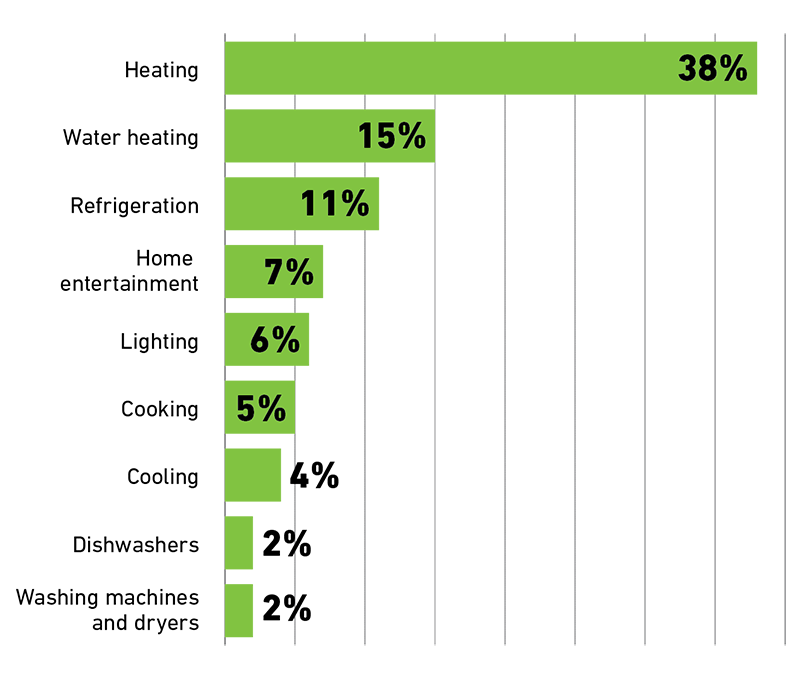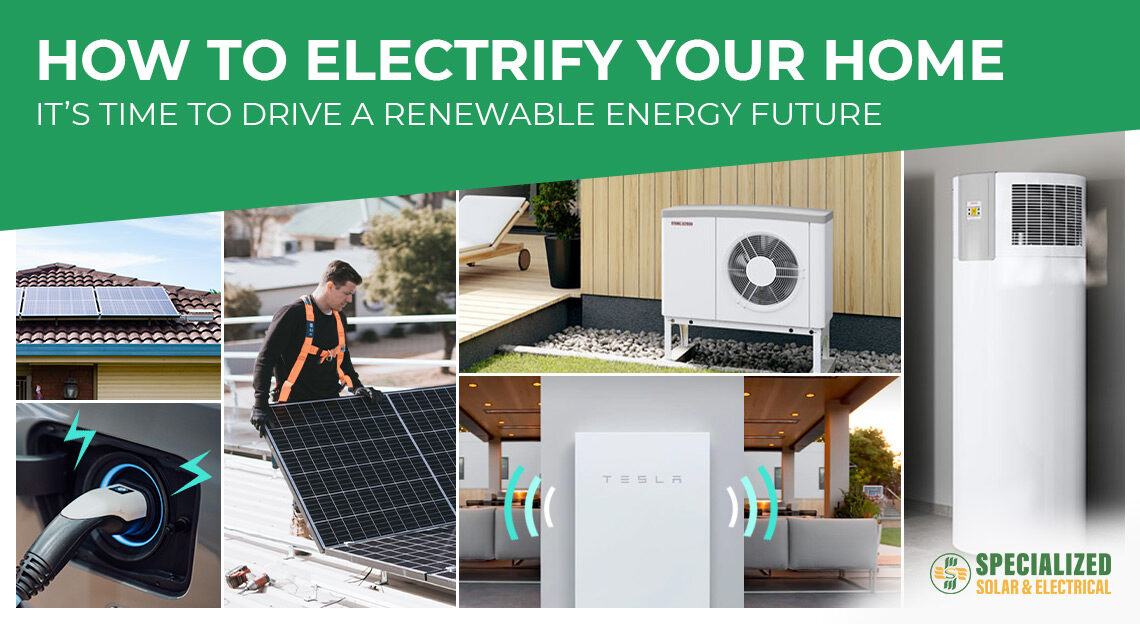Home electrification is set to be big in 2023. That’s because Aussie homeowners are realising they can massively reduce their energy bills and carbon emissions through electrification, powered by solar. In fact, modelling shows the average household could save $5,000 a year on power and the cost of owning cars and appliances by going all-electric and installing solar and batteries.1
On this blog, we explain why making your home all-electric is good for your hip pocket as well as the environment – and the steps you can take to make it happen in 2023.
- How you save money by going all-electric
- What the biggest energy costs are in the home
- Steps you can take to electrify your home
How you save money by going all-electric
In an electrified home, you save money in two main ways:
- using less energy by upgrading to super-efficient electric appliances
- generating your own solar electricity to power your electric appliances.
Efficient electric appliances, like heat pumps, can be up to four times more energy efficient than standard electric or gas alternatives. And if you power these appliances with your own solar, you save even more.
In contrast, if you stay on gas, you’ll always have to buy it. And with gas prices predicted to rise by over 40% in the next two years, that’s not a happy prospect!
Whilst it’s true that electricity prices are also predicted to rise, you can avoid the electricity price hikes by running your home on electricity and powering it with your own solar energy.
Where the biggest energy costs are in the home
Before getting started on your home electrification project, it’s a good idea to know what the biggest energy guzzlers are in your home.
By far the biggest energy culprit in most Victorian homes is heating, accounting for up to 40% of the typical energy bill.
Next is the hot water service, accounting for around 20% of total energy running costs.
Older appliances can also gobble up lots of energy, as can halogen lights and home entertainment systems like big-screen TVs and gaming consoles.
Each home uses energy differently. So, a great way to pinpoint the energy guzzlers in your home is to get a free home energy monitor. Get in touch if you’d like one for your home.

Steps you can take to electrify your home
Here are ten steps you can take to make your home all-electric electric, powered by solar. You can think of it as a recipe for full electrification, with the steps as a guide. If you want to change the order of the steps, you’ll still end up with a great outcome!
Step 1: Insulate and draft-seal
For starters, it’s a good idea to properly insulate your home and draft-seal the windows and doors. It’s about getting the basics right, so your energy efficiency improvements don’t go to waste. Insulation typically costs between $1,400 to $4,000 depending on the size of your home.2 If budget is tight, prioritise ceiling and floor insulation as that’s where most energy is lost. Draft-sealing is low-cost and makes a big difference plus there are government rebates we can help you access making it even more affordable.
Step 2: Install solar panels
Ideally your second step should be to install a big enough solar system that has the capacity to fully power your home once it’s completely electrified. The average size solar system being installed on Aussie homes has increased to 8kW as more people prepare for greater electrification, home battery storage and EV charging. If you already have solar and you want to add more solar panels or upgrade your system, get in touch with our solar experts. That way you’ll get the best solar system to power your home now, and in the future.
Step 3: Sort out your heating
Because heating accounts for around 40% of the total energy bill of most Victorian homes, it makes sense to upgrade to an energy efficient electric heating system. According to Sustainability Victoria3, the cheapest and greenest way to heat your home is with a reverse-cycle air conditioner. And, of course, there’s the added bonus that it cools your home in summer!
Step 4: Get a heat pump hot water system
Your hot water heating system could be next on your list as it’s probably the second biggest energy guzzler in your home. Resistive electric hot water systems are super-expensive to run, and gas is not far behind. Switching to a heat pump hot water system will provide you with plenty of hot water, even in sub-zero temperatures, at around one-quarter the cost. And the good news is that there are generous government rebates to help households with the cost of upgrading to a heat pump hot water system.
Step 5: Upgrade old appliances
Old appliances like fridges and clothes dryers could be costing you a fortune to run. That ten-year old beer fridge in the carport might be costing $300 a year in electricity.4 It’s worth spending now to replace old appliances with energy efficient versions. When shopping around, look at the energy rating labels on appliances – the more stars the better. Whilst appliances with a top energy rating are more expensive, they’re worth the investment as you’ll be saving more in the long run.
Step 6: Switch to an electric induction cooktop
Electrifying your kitchen is a great way to cut your power bills and make your home safer. The best alternative to gas cooking is an electric oven teamed with an induction cooktop. Induction cooktops use an electromagnetic current to heat pans making them super-safe and highly energy efficient.
Step 7: Install a solar battery
The economics of home battery storage keep improving due to rising electricity prices and falling battery costs. Our modelling shows that solar-plus-battery systems can achieve a payback of around five years – and that this will only improve if electricity prices skyrocket as predicted. And the icing on the cake with battery storage is that it puts you in pole position to trade your solar energy on the wholesale electricity market, saving you even more.
Step 8: Upgrade to an electric car
With electric vehicle prices falling, government incentives improving and a burgeoning second-hand EV market, chances are your next car will be electric. These days, filling up at the pump probably costs more than heating your home. That’s why upgrading your fuel-injection car to one that’s electric makes a lot of sense. Even without solar, you’ll be saving hundreds if not thousands of dollars a year on motoring. And with your own solar-charging set-up, the savings are even greater.
Step 9: Monitor your solar
Measure it, and you can manage it. That business advice applies to home energy as well. That’s why we install comprehensive solar generation and consumption monitoring with every solar system. Via your smart phone or a laptop, you can see how much solar electricity your solar system is producing, how much electricity you’re using – and what you’re saving. Don’t settle for anything less!

Step 10: Make your home energy-smart
With your home running on electricity, there’s an amazing opportunity to automate the way the appliances work, when they operate and where they draw power from. You can start small with smart plugs to experiment, then upgrade to a smart home hub which acts as a centralised tool for controlling all your electric devices and appliances. Better still, a smart home hub will know that when you leave home to switch off the aircon, turn off the lights and heating or cooling – according to the pre-set instructions you’ve created.
Request a tailored electrification plan for your home
If you’d like to get started on the journey to full electrification, get in touch. We’re solar and electrical experts with the skills, products, and services to get your home running 100% on electricity, powered by solar.
References
1 https://www.energymagazine.com.au/household-electrification-savings-not-sacrifice/
2 https://www.climatecouncil.org.au/top-tips-improve-home-energy-efficiency/
3 https://www.sustainability.vic.gov.au/energy-efficiency-and-reducing-emissions/save-energy-in-the-home/reduce-heating-costs-at-home/choose-the-right-heating-system-for-your-home
4 https://www.climatecouncil.org.au/top-tips-improve-home-energy-efficiency/



 Learn more: Accessing wholesale retailer prices.
Learn more: Accessing wholesale retailer prices.










